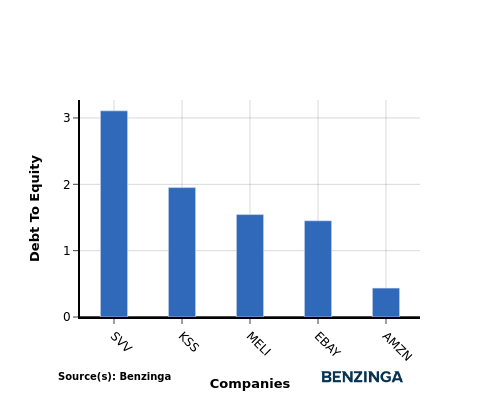
In today's rapidly changing and highly competitive business world, it is vital for investors and industry enthusiasts to carefully assess companies. In this article, we will perform a comprehensive industry comparison, evaluating Amazon.com (NASDAQ:AMZN) against its key competitors in the Broadline Retail industry. By analyzing important financial metrics, market position, and growth prospects, we aim to provide valuable insights for investors and shed light on company's performance within the industry.
Amazon.com Background
Amazon is the leading online retailer and marketplace for third party sellers. Retail related revenue represents approximately 75% of total, followed by Amazon Web Services' cloud computing, storage, database, and other offerings (15%), advertising services (5% to 10%), and other the remainder. International segments constitute 25% to 30% of Amazon's non-AWS sales, led by Germany, the United Kingdom, and Japan.
| Company | P/E | P/B | P/S | ROE | EBITDA (in billions) | Gross Profit (in billions) | Revenue Growth |
|---|---|---|---|---|---|---|---|
| Amazon.com Inc | 35.36 | 7.54 | 3.59 | 5.79% | $36.48 | $78.69 | 8.62% |
| Alibaba Group Holding Ltd | 15.26 | 1.93 | 1.98 | 1.23% | $59.0 | $117.63 | -15.6% |
| PDD Holdings Inc | 11.32 | 3.27 | 2.79 | 4.59% | $16.09 | $54.73 | 10.21% |
| MercadoLibre Inc | 62.98 | 25.94 | 5.80 | 10.56% | $0.92 | $2.77 | 36.97% |
| Coupang Inc | 212.93 | 12.38 | 1.76 | 2.53% | $0.36 | $2.32 | 11.16% |
| JD.com Inc | 8.09 | 1.47 | 0.30 | 4.6% | $14.27 | $47.85 | 15.78% |
| eBay Inc | 17.71 | 6.86 | 3.50 | 9.95% | $0.77 | $1.86 | 1.13% |
| Ollie's Bargain Outlet Holdings Inc | 41.06 | 4.73 | 3.52 | 2.78% | $0.07 | $0.24 | 13.35% |
| Vipshop Holdings Ltd | 7.64 | 1.36 | 0.53 | 4.85% | $2.45 | $6.08 | -4.98% |
| Dillard's Inc | 11.44 | 3.48 | 1.01 | 8.97% | $0.26 | $0.69 | -1.64% |
| MINISO Group Holding Ltd | 16.19 | 3.67 | 2.24 | 3.98% | $0.65 | $1.96 | 18.89% |
| Macy's Inc | 5.62 | 0.68 | 0.14 | 0.84% | $0.31 | $2.0 | -4.14% |
| Savers Value Village Inc | 74.07 | 3.89 | 1.11 | -1.13% | $0.03 | $0.2 | 4.51% |
| Kohl's Corp | 7.64 | 0.25 | 0.06 | -0.4% | $0.23 | $1.4 | -4.41% |
| Hour Loop Inc | 140 | 8.46 | 0.35 | 11.93% | $0.0 | $0.01 | 4.68% |
| Average | 45.14 | 5.6 | 1.79 | 4.66% | $6.82 | $17.12 | 6.14% |
Through a meticulous analysis of Amazon.com, we can observe the following trends:
A Price to Earnings ratio of 35.36 significantly below the industry average by 0.78x suggests undervaluation. This can make the stock appealing for those seeking growth.
The elevated Price to Book ratio of 7.54 relative to the industry average by 1.35x suggests company might be overvalued based on its book value.
With a relatively high Price to Sales ratio of 3.59, which is 2.01x the industry average, the stock might be considered overvalued based on sales performance.
With a Return on Equity (ROE) of 5.79% that is 1.13% above the industry average, it appears that the company exhibits efficient use of equity to generate profits.
The company exhibits higher Earnings Before Interest, Taxes, Depreciation, and Amortization (EBITDA) of $36.48 Billion, which is 5.35x above the industry average, implying stronger profitability and robust cash flow generation.
The gross profit of $78.69 Billion is 4.6x above that of its industry, highlighting stronger profitability and higher earnings from its core operations.
The company is experiencing remarkable revenue growth, with a rate of 8.62%, outperforming the industry average of 6.14%.
Debt To Equity Ratio

The debt-to-equity (D/E) ratio is a measure that indicates the level of debt a company has taken on relative to the value of its assets net of liabilities.
Considering the debt-to-equity ratio in industry comparisons allows for a concise evaluation of a company's financial health and risk profile, aiding in informed decision-making.
In light of the Debt-to-Equity ratio, a comparison between Amazon.com and its top 4 peers reveals the following information:
Amazon.com demonstrates a stronger financial position compared to its top 4 peers in the sector.
With a lower debt-to-equity ratio of 0.44, the company relies less on debt financing and maintains a healthier balance between debt and equity, which can be viewed positively by investors.
Key Takeaways
For Amazon.com, the PE ratio is low compared to its peers in the Broadline Retail industry, indicating potential undervaluation. The high PB and PS ratios suggest that the market values Amazon.com's assets and sales highly. In terms of ROE, EBITDA, gross profit, and revenue growth, Amazon.com outperforms its industry peers, reflecting strong financial performance and growth potential.
This article was generated by Benzinga's automated content engine and reviewed by an editor.